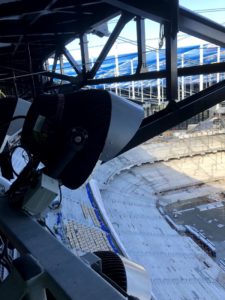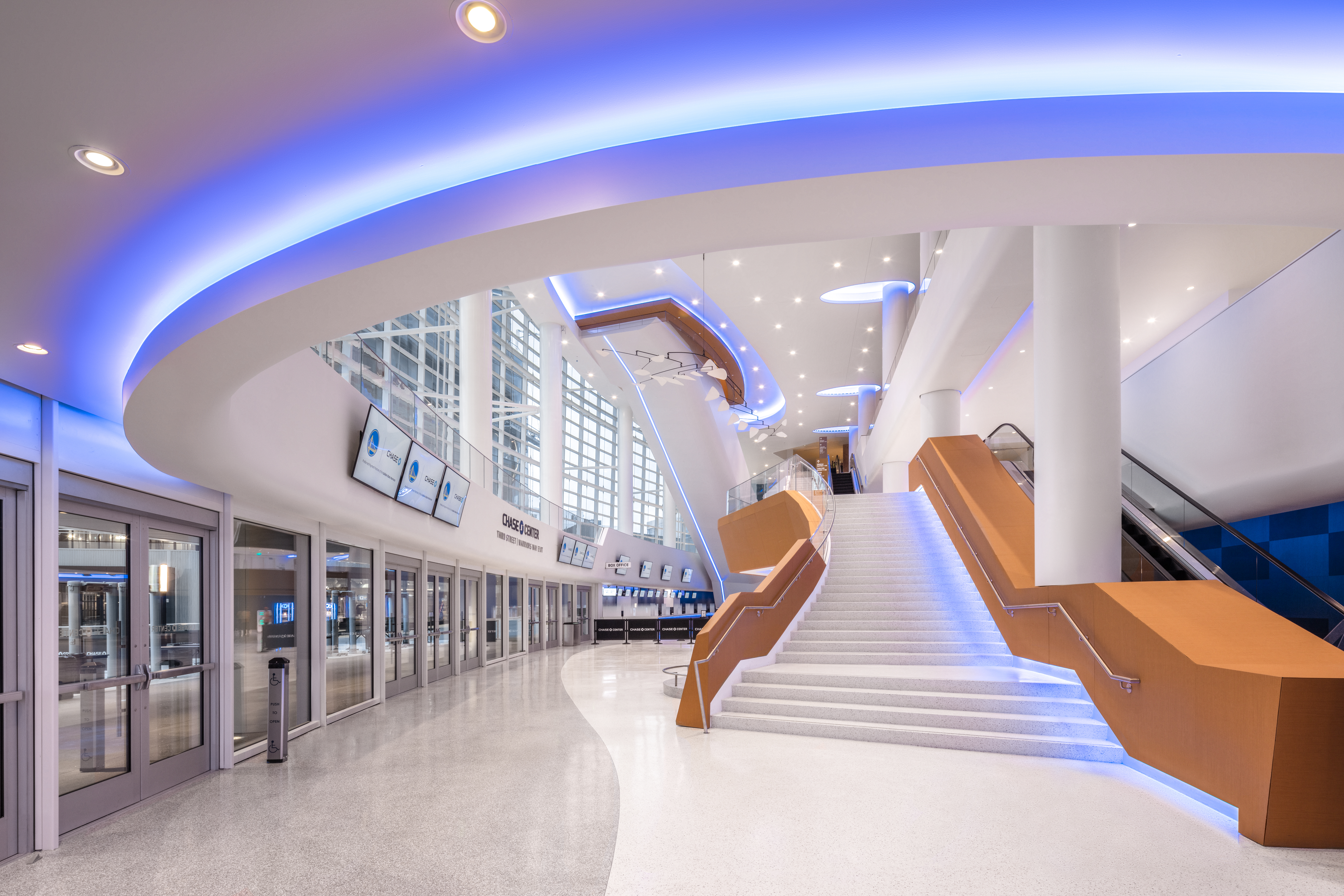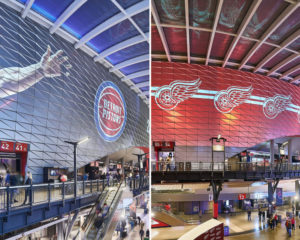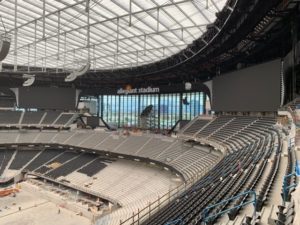Sports Lighting Around Reliable Electrical Systems
Unfortunately for the players of Super Bowl XLVII, any on-field action is probably the third-most memorable event for the casual viewer. The 2013 game is most known for either Beyoncé’s halftime show or for the lights going out early in the third quarter. Parts of the stadium went dark for over thirty minutes, leaving fans and viewers confused. No, Beyoncé didn’t cause the blackout; an “abnormality” in the power system due to the relay protection system triggered an automatic shutdown, forcing backup systems to kick in.
As venues become more technology driven and the increased emphasis on an elevated fan experience continues, facility managers and the engineers that support them are working behind the scenes to ensure that the electrical systems are designed to handle everything, including sports and event lighting, network driven technology, fan comfort, and fan safety.
 Designing the lighting for an arena or stadium takes a different approach than for a hospital, classroom, or commercial office building. A great sports lighting system does more than just illuminate the field of play, it impacts the comfort of spectators and ensures a quality television broadcast for fans watching at home. Experienced electrical engineers and designers understand the differences in system configurations for practice, recreational, and facilities used for national broadcast events. They know to consider a venue’s capacity and the distances from which spectators are viewing the action when designing the lighting system. Sports lighting designers must consider vertical and horizontal illuminance (and televised vs non-televised venues), uniformity, glare restriction, shadows, color, and flickering on the field of play; they are also responsible for lighting the fans, reducing light pollution in the area surrounding the facility, and safety lighting.
Designing the lighting for an arena or stadium takes a different approach than for a hospital, classroom, or commercial office building. A great sports lighting system does more than just illuminate the field of play, it impacts the comfort of spectators and ensures a quality television broadcast for fans watching at home. Experienced electrical engineers and designers understand the differences in system configurations for practice, recreational, and facilities used for national broadcast events. They know to consider a venue’s capacity and the distances from which spectators are viewing the action when designing the lighting system. Sports lighting designers must consider vertical and horizontal illuminance (and televised vs non-televised venues), uniformity, glare restriction, shadows, color, and flickering on the field of play; they are also responsible for lighting the fans, reducing light pollution in the area surrounding the facility, and safety lighting.
It’s important for a design team to understand the design of a sports lighting system should not only be efficient, but it needs to be flexible and automated. In the design of complex venues, we have controls systems that integrate a complex universe of separate systems into one operational interface that can be scheduled from a single source. Many venues will now have DMX for the stadium and arena bowl and event lighting, interior lighting controls designed down to each space and fixture, and controls for any theatrical lighting in the bowl. The event technology manager can preprogram and schedule scenes for the entire building down to specific days and events. It’s also important that the system allows for flexibility to modify that programming on-the-fly inside during an event when there is a team win, emergency alert, or adjustment to a pregame routine to flash the arena bowl lighting. Lighting is there to be color-tuned and express the emotion of the events as they happen in real time, all while giving operational control to the building staff to focus on energy consumption.
Reliability and Redundancy
A resilient electrical system is designed so that the delivery of power to the stadium or arena has multiple levels of reliability and redundancy at the utility and into the building’s electrical distribution. The design team, with the owner, should work with the local utility to negotiate the best scenario of power to the site based on the owner’s most critical success factors. It’s imperative to study the risk associated at each level of distribution: utility, building distribution at each quadrant, and all the way to the branch, end-use point of connection. Each of these levels can be metered independently to provide the operator with energy trend data for the ability to optimize the usage of their building, while maintaining operational costs.
Technology
For many venues, the electrical equipment is designed and procured two years before the building, which is often expected to be technologically state-of-the-art when it comes online. It is important that your design team has the experience of how these buildings tie together at the end of construction with considerations towards sponsorships, signage, video boards, wireless cellular technologies similar to 5G implementation, network infrastructure, etc.
Just as important is understanding where the power components want to be clustered and designing a system around flexibility and adaptability. With the continuous development in technology, systems should allow a venue to swap out yesterday’s technology for the latest system without redesigning and replacing an entire switchboard section. It takes actualized data history to design these systems effectively and provide the most advantageous cost benefit to the owners and operators.
What’s next for the future of these facilities? We continue to see the emphasis placed on the fan and player experience with both safety and comfort in mind. It’s important to remember that everyone is attending a game or event for the experience, connection, and community surrounding them. With that, we see emerging technologies continuing to drive these experiences for more adaptable and flexible electrical systems to react quickly to the needs of the building and ensure there is no break in the action.
For those of you wondering, after play resumed, the Biltmore Ravens defeated the San Francisco 49ers 34-31.
Chase Center – Technology
 For the Chase Center in San Francisco, CA (home to the NBA’s Golden State Warriors), there was a late shift to integrate 5G technology into the building. The team wanted the flexibility to build on technologies like augmented reality and app-based experiences, real time data analytics driving fan experience, and intelligent automation, to name a few. We also knew they needed a design that was flexible, scalable, and secure. SSR looked at each piece of equipment being installed, taking time to understand its capacity and power requirements in both the AC and DC systems. By doing this, we were able to reduce the requested amount of power from the initial ask of 5,000 amps down to 1,000 amps based on more understanding around the equipment and educating our low voltage partners on power design versus what was requested for supply.
For the Chase Center in San Francisco, CA (home to the NBA’s Golden State Warriors), there was a late shift to integrate 5G technology into the building. The team wanted the flexibility to build on technologies like augmented reality and app-based experiences, real time data analytics driving fan experience, and intelligent automation, to name a few. We also knew they needed a design that was flexible, scalable, and secure. SSR looked at each piece of equipment being installed, taking time to understand its capacity and power requirements in both the AC and DC systems. By doing this, we were able to reduce the requested amount of power from the initial ask of 5,000 amps down to 1,000 amps based on more understanding around the equipment and educating our low voltage partners on power design versus what was requested for supply.
Little Caesars Arena – Designing for NHL and NBA
Little Caesar’s Arena in Detroit, MI, opened in the fall of 2017 as the new home to the NHL’s Detroit Red Wings and NBA’s Detroit Pistons. One of the primary challenges for the project  was a decision during the construction phase to modify the arena from an NHL hockey-only venue to one that would accommodate the Pistons as well. This specific challenge required SSR to redevelop the arena bowl lighting in a way that would provide the best-in-class lighting for both NHL and NBA events. We considered how each system would integrate and be controlled so that we could design the electrical infrastructure around the energy usage. All of this was being designed as the structure was going up. SSR was able to work cohesively with the client, both professional leagues, the contractor team, and our suppliers to provide the best solution at the time. We had to keep in mind the color temperature requirements for both leagues were different, along with aiming toward different playing surface dimensions. SSR was able to leverage strong relationships with each league to get the best expertise in the room to provide the optimal solution for both playing conditions.
was a decision during the construction phase to modify the arena from an NHL hockey-only venue to one that would accommodate the Pistons as well. This specific challenge required SSR to redevelop the arena bowl lighting in a way that would provide the best-in-class lighting for both NHL and NBA events. We considered how each system would integrate and be controlled so that we could design the electrical infrastructure around the energy usage. All of this was being designed as the structure was going up. SSR was able to work cohesively with the client, both professional leagues, the contractor team, and our suppliers to provide the best solution at the time. We had to keep in mind the color temperature requirements for both leagues were different, along with aiming toward different playing surface dimensions. SSR was able to leverage strong relationships with each league to get the best expertise in the room to provide the optimal solution for both playing conditions.
Allegiant Stadium – Design with the Future of NFL Stadiums in Mind
 Allegiant Stadium is currently under construction in Las Vegas, NV and will be the new home to the Raiders NFL franchise. The stadium is fitted with 65,000 seats, a translucent EFTE roof, a movable playing field tray with natural grass, and an operable wall facing the Las Vegas strip. The stadium is scheduled to be complete and open in August of 2020.
Allegiant Stadium is currently under construction in Las Vegas, NV and will be the new home to the Raiders NFL franchise. The stadium is fitted with 65,000 seats, a translucent EFTE roof, a movable playing field tray with natural grass, and an operable wall facing the Las Vegas strip. The stadium is scheduled to be complete and open in August of 2020.
The original architectural design vision for the interior of the stadium bowl included decorative “ribbon” elements that ring and frame the upper seating areas with a combination of LED displays and bowl ductwork. After many design iterations of focus on the catwalk location with the ribbon and bowl ductwork elements, the sports lighting design was studied to ensure the proper aiming angles could still be achieved to provide best-in-class lighting on the field and reduce glare, including skip glare, for the fans and broadcast cameras.
With a desire to host a Vegas-sized Super Bowl, electrical system reliability was at the forefront of the decision-making design process and how our team could provide a rightsized system for all the needs of the stadium. Anticipating the technology needs around a robust wireless network and ensuring an adaptable system to maximize the fan experience were some of the keys to success in determining the best approach to how the system was configured.
For comments or questions, contact Scott Terry, PE at 615.460.0538 or sterry@ssr-inc.com.







